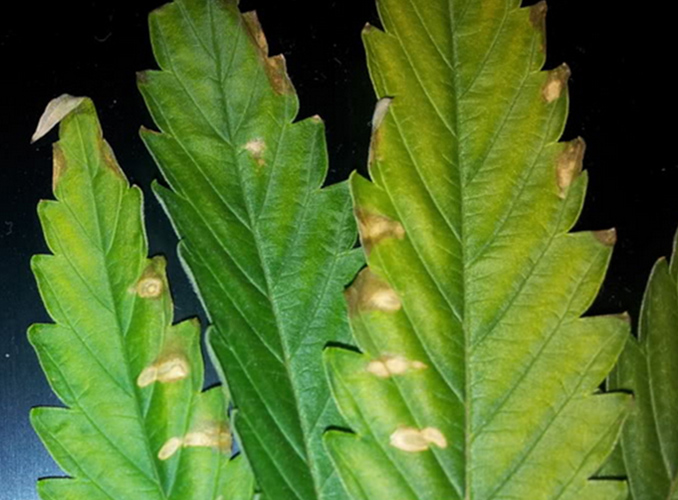How To Spot And Treat Calcium Defiencies In Cannabis Plants
Published :
Nov 23, 2017
Categories :
Cannabis cultivation

A calcium deficiency has the possibility to harm or reduce your harvest or your cannabis plants’ new growth. Since every grower wants to have the biggest yield their plants can possibly produce spotting deficiencies early can make a huge difference.
Humans and animals use calcium to form bone structure, teeth and repair broken tissue. Plants, like humans and animals, also use calcium to strengthen and hold together its cell walls. It is one of the plants secondary needs together with magnesium and sulphur. These are used in conjunction with the primary needs (phosphorus, potassium and nitrogen) to keep the plant healthy, strong and growing new leaves and stems. Calcium is also used by plant to activate specific enzymes that have the ability to coordinate cellular activities within the plant. In short terms calcium provides structure to the plants stems and leaves and makes it withstand stress from external sources (like overheating) better.
Calcium is what is called a semi mobile nutrient, which means that it is not transported well throughout the plant and tends to stay in the places of the plant that it has been administered to. For instance if you spray one of the cannabis plants leaves with a calcium solution it tends to stay in place on that leaf. This property is crucial to the treatment of calcium deficiency in cannabis plants.
Be warned, though, that it is not easy to spot a calcium deficiency and diagnose it correctly. Calcium deficiencies usually occur in conjunction with a deficiency of iron or magnesium but it could also be caused by periods of low humidity or prolonged low temperatures. Because calcium is only transported throughout the plant by a process called transpiration, this means that the root system takes calcium from the soil mix in which it is grown and transports it to the new leaves and new growth where the calcium is needed.
HOW TO SPOT A CALCIUM DEFICIENCY IN CANNABIS PLANTS
When looking for calcium deficiencies in cannabis plants keep an eye for the newly formed leaves at the top of the plant and the fan leaves that receive direct light. The signs may vary from dead spots that are surrounded by darker green and crinkling of the leaves to stunted growth and curled tips. Eventually the leaves may even die off.
The stems of your cannabis plant may become weaker or even hollow which causes the plant to be more susceptible to heat stress. The buds may develop slow or display stunted growth. A calcium deficiency can also cause cannabis plants to have the root system weakened, more susceptible to diseases and the root system could even turn brown and eventually completely die off.
There are certain situations in which cannabis may be more susceptible to calcium deficiencies than others. Growers that use reversed osmosis water, water that is filtered to be extremely pure, should make sure to provide enough calcium in addition to regular watering. Tap water usually contains calcium so unless you are using heavily filtered water or hydroponics you are probably safe. Coco fibres, or any other growing medium with very high acidic values, tend to have a low pH value of below 6.2, which makes it harder for the cannabis plants to uptake the calcium into the root system. Overfeeding potassium could also cause your plants to display signs of calcium deficiency.

SOLUTIONS FOR CALCIUM DEFICIENCY
The first thing to do when you have spotted a calcium deficiency in your cannabis plants is to check the pH levels of your growing medium. For cannabis plants growing in soil the best range of pH levels to absorb calcium would be between 6.2 and 7.0 pH. If your cannabis plants are in a hydro culture the best range would be between 6.2 and 6.5 pH. When the pH of your growing medium is not in the ideal range flush your pots or hydro culture with clean water that has been altered to have the correct pH range.
The second step to combatting a calcium deficiency in cannabis plants would be to add some nutrients in the form of fertilizer or supplements. This can be added after the flushing and will help your plants to regain their strength. Since a calcium deficiency rarely occurs isolated, and is often in conjunction with magnesium and iron deficiencies, it might be a smart solution to give your plants a cocktail of these supplements. The most common is a mix of calcium and magnesium; known as Cal-Mag supplements.
Dolomite lime is a form of calcium that will slowly dissolve over time. This property makes it an excellent supplement to your growing medium. Dolomite also has a pH level of around 7.0, which is the optimal pH level for growing cannabis plants. Mix in about 150 grams of dolomite to 20 litres of soil or earth in a large enough container and water it down with pH corrected water. After the soil has settled the plants can be added to benefit the added calcium deposits.
Even with al these solutions it is very unlikely that the affected leaves and stems will ever recover completely and the damaged areas will remain. When looking for signs if your chosen treatment is helping look at the newly formed leaves and buds.






































